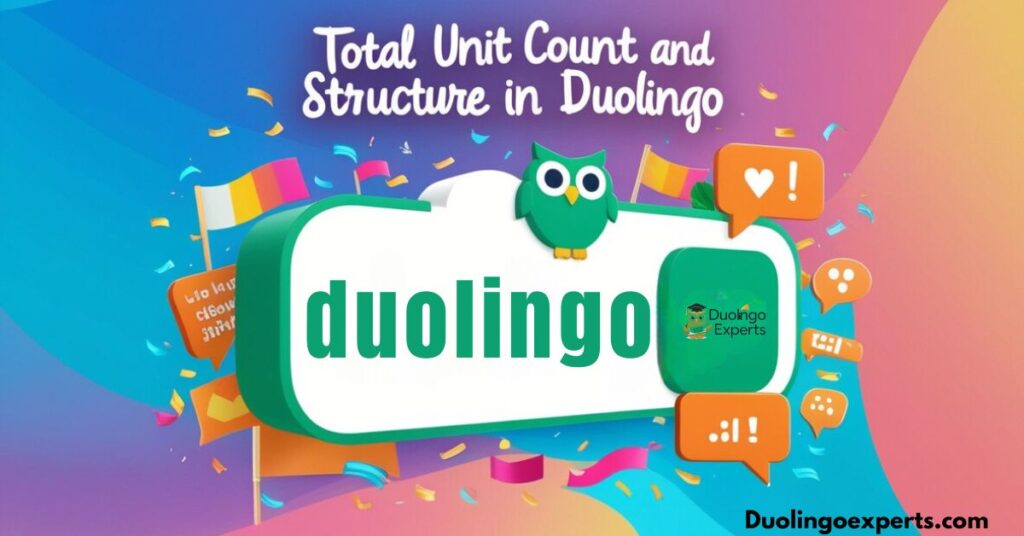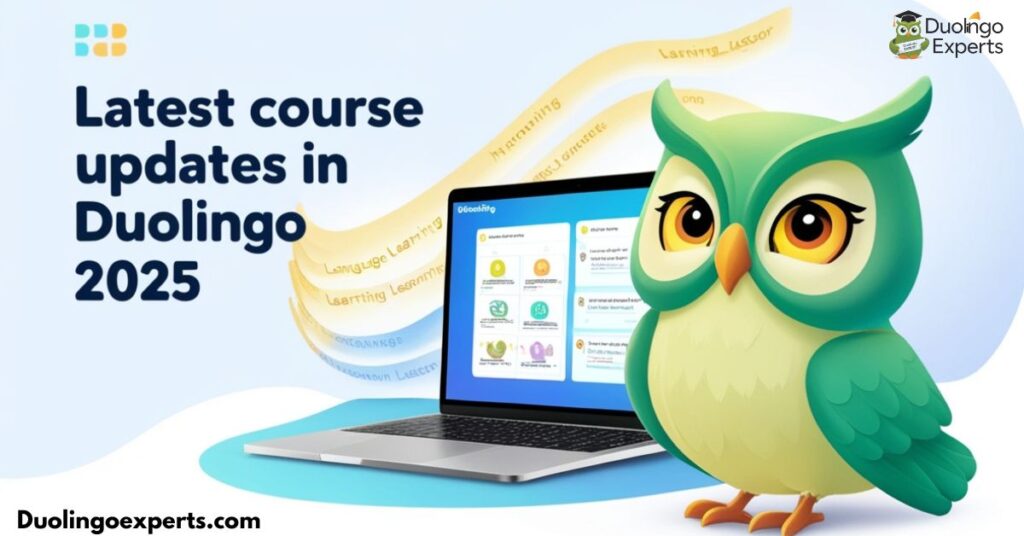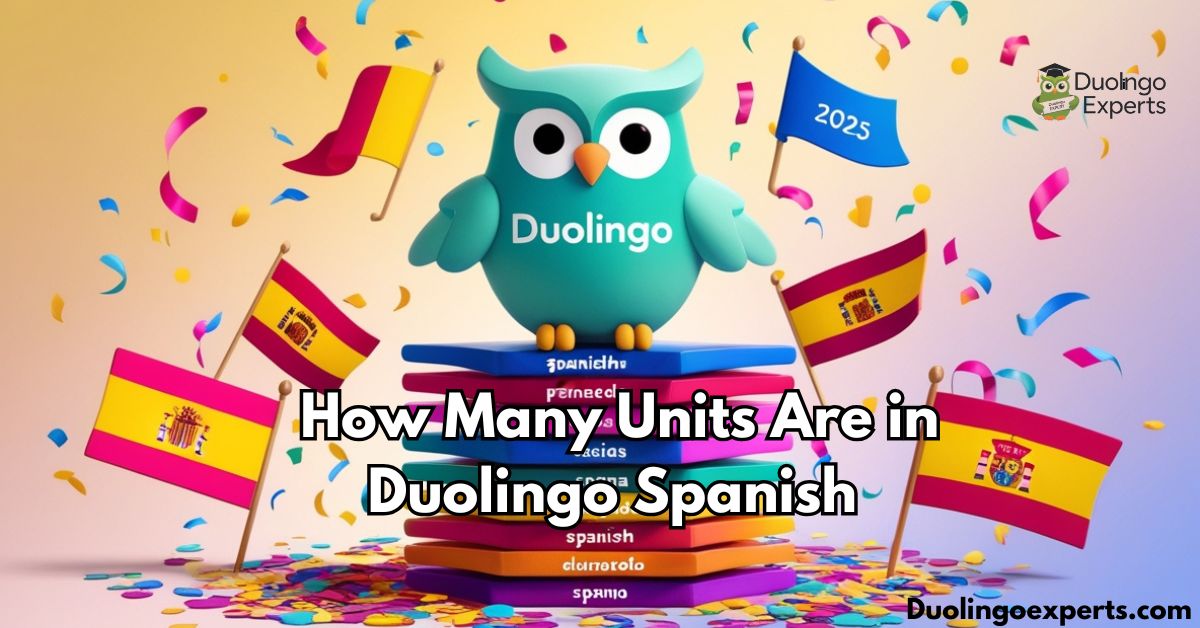Learning Spanish has never been more accessible, thanks to modern platforms like Duolingo. Whether you’re just starting out or looking to sharpen your advanced Spanish skills, Duolingo’s Spanish course provides a flexible, engaging, and gamified approach to mastering the language.
In this article, we will reveal how many units are in Duolingo Spanish in 2025, move deep into the course structure, and explore how each unit plays a crucial role in guiding you from beginner to advanced Spanish proficiency.
Key Takeaways
Before we dive into the specifics of Duolingo’s Spanish course, here’s a quick summary of the key facts about the course as of 2025:
- The Duolingo Spanish course consists of 230 units.
- The units are divided into 9 main sections, each focusing on different language skills and proficiency levels.
- There are a total of 7,422 lessons included in the course.
- 347 interactive stories and podcasts help with practical speaking and listening exercises.
- The course is designed to align with CEFR proficiency levels, covering A1 to B2.
Now that we have a general overview, let’s dive deeper into the specifics of the Duolingo Spanish course in 2025.
How Many Units Are in Duolingo Spanish?
In 2025, the Duolingo Spanish course consists of 230 units spread across 9 distinct sections. These sections are carefully designed to take learners through different stages of Spanish language acquisition. From basic vocabulary and sentence construction in the early stages, to more advanced grammar and conversational topics, Duolingo provides a structured yet flexible path for Spanish learners.
Total Unit Breakdown
| Section Name | Proficiency Level | Number of Units |
|---|---|---|
| Rookie | Beginner | 26 |
| Explorer | Beginner to Low Intermediate | 28 |
| Traveler | Low Intermediate | 30 |
| Trailblazer | Intermediate | 33 |
| Adventurer | Intermediate to Advanced | 35 |
| Master | Advanced | 39 |
| Fluent | Advanced | 40 |
| Expert | Advanced Proficiency | 44 |
| Ultimate | Mastery | 44 |
Section Breakdown
Each of these 9 sections is designed to help learners progress from the most basic concepts to advanced proficiency, ensuring they gain mastery over all aspects of the language.
Total Unit Count and Structure in Duolingo

The 230 units in the Duolingo Spanish course are spread across these 9 sections. This distribution is crafted in a way that learners can build foundational skills before moving on to more complex grammar and sentence structures. As you progress through the units, you’ll find that the material becomes increasingly difficult, challenging learners to think critically and apply their knowledge in real-world contexts.
Unit Structure and Themes
Each unit typically includes a combination of various lesson types:
- Vocabulary lessons that focus on building practical, everyday language skills.
- Grammar exercises that introduce learners to key structures, such as verb conjugations, sentence building, and tense usage.
- Speaking and listening activities that use Duolingo’s voice recognition technology to help learners perfect their pronunciation and improve listening comprehension.
- Interactive stories and podcasts that simulate real-life conversations, helping learners practice conversational Spanish.
- Writing and reading exercises that reinforce grammar and vocabulary while improving literacy.
The course includes a range of activities designed to ensure learners gain proficiency in all language skills: speaking, listening, reading, and writing. This makes the Duolingo Spanish course a holistic language learning program.
Unit Distribution Across Proficiency Levels
The Duolingo Spanish curriculum is designed to take learners through the CEFR proficiency levels of language learning: A1 (beginner), A2 (elementary), B1 (intermediate), and B2 (upper-intermediate). Each section of the course corresponds to a specific proficiency level, ensuring that learners can follow a logical path as they progress.
CEFR Proficiency Levels in Duolingo Spanish
- A1 (Beginner): This level introduces learners to basic vocabulary and grammar. You’ll learn how to introduce yourself, order food, ask for directions, and use simple phrases in everyday contexts. Sections: Rookie, Explorer.
- A2 (Elementary): At this stage, you’ll expand your vocabulary to include more complex topics such as family, hobbies, time, and basic verb conjugations. Sections: Traveler, Trailblazer.
- B1 (Intermediate): You’ll engage in more detailed conversations, discussing past experiences, future plans, and more abstract concepts. Sections: Adventurer, Master.
- B2 (Upper-Intermediate): This level prepares learners for fluent communication. You’ll use the subjunctive mood, discuss advanced topics, and master Spanish sentence structure. Sections: Fluent, Expert, Ultimate.
Latest Course Updates in Duolingo 2025

In 2025, Duolingo has continued to refine its Spanish course, incorporating feedback from millions of learners worldwide. The course now includes new features, interactive lessons, and updated content to enhance the learning experience.
What’s New in 2025?
- New Vocabulary Lessons: Duolingo has added more context-specific vocabulary, including terms related to modern technology, business, and culture. These lessons are designed to help learners engage with contemporary Spanish in real-world situations.
- Enhanced Speaking and Listening Exercises: Duolingo has improved its voice recognition technology, making pronunciation exercises more accurate and engaging. New listening comprehension activities are also included, helping you understand various Spanish accents and speaking styles.
- Additional Interactive Stories: With over 347 interactive stories now available, learners can immerse themselves in conversational Spanish, improving both comprehension and speaking fluency.
- Podcast Integration: Duolingo has incorporated more podcasts into the learning experience. These Spanish podcasts cover a variety of topics, allowing learners to improve their listening skills while learning about Spanish-speaking cultures.
These updates reflect Duolingo’s commitment to providing a dynamic and engaging learning experience that adapts to the needs of its users.
Core Spanish Course Components
The Duolingo Spanish course is composed of several core components designed to enhance different language skills. Let’s take a closer look at what each component entails:
Vocabulary and Grammar Lessons
Duolingo focuses on building a solid vocabulary foundation early on, ensuring learners are equipped with the essential words and phrases needed for everyday communication. Grammar lessons build upon this, introducing more complex structures as learners progress.
- Vocabulary: Key words and phrases related to topics like food, family, work, travel, and more.
- Grammar: Learn how to use different tenses, conjugations, sentence structures, and more advanced grammar topics.
Interactive Learning
One of the most engaging features of Duolingo is its emphasis on interactive learning. Rather than just memorizing words and rules, Duolingo incorporates interactive exercises, including:
- Duolingo stories: These simulate real-life scenarios, allowing you to practice listening and speaking.
- Podcasts: Focus on improving listening skills, while also giving cultural insights into the Spanish-speaking world.
- Speaking exercises: Improve pronunciation with voice recognition technology, helping you sound more natural.
Speaking and Listening Exercises
The speaking and listening activities in Duolingo’s Spanish course are essential for building conversational fluency. You will engage in tasks that require you to speak out loud, providing immediate feedback on pronunciation accuracy. Additionally, listening comprehension exercises improve your ability to understand spoken Spanish in various accents and speeds.
CEFR Alignment and Progression
Duolingo’s Spanish course is aligned with the CEFR framework, ensuring that learners can track their progress from beginner to advanced Spanish. As you move through the sections, you’ll notice that the complexity of the content increases, allowing for a natural progression from A1 to B2.
CEFR Breakdown in Duolingo Spanish
| Proficiency Level | Section | Key Skills |
|---|---|---|
| A1 (Beginner) | Rookie, Explorer | Basic vocabulary, introductions, ordering food, and common phrases. |
| A2 (Elementary) | Traveler, Trailblazer | Describing routines, talking about family and hobbies, expressing preferences. |
| B1 (Intermediate) | Adventurer, Master | Talking about past events, discussing future plans, using the past tense. |
| B2 (Upper-Intermediate) | Fluent, Expert, Ultimate | Mastery of grammar, including subjunctive mood, complex sentence structures, and real-world conversations. |
The CEFR alignment ensures that learners gain the skills needed for real-world communication and can see their progress in measurable terms.
Lesson Types and Learning Methods
Duolingo employs a range of lesson types to cater to different learning styles. Here are some of the key methods used:
- Multiple Choice: Answer questions by selecting the correct translation or matching words.
- Fill-in-the-Blank: Practice sentence construction and grammar by completing missing words.
- Speaking: Pronounce sentences and words aloud to practice pronunciation and fluency.
- Listening: Comprehend spoken Spanish by answering questions based on the audio.
- Story-Based Learning: Engage in interactive Spanish exercises by completing stories that mirror real-life situations.
These methods ensure that learners are exposed to all aspects of language learning, helping them develop well-rounded language skills.
Frequently Asked Questions
How many units are there in Duolingo Spanish?
Duolingo Spanish course contains a total of 230 units. These units are divided into 9 sections, covering all levels from beginner to advanced proficiency.
How many units Duolingo Spanish?
Duolingo’s Spanish course consists of 230 units in total. These units are spread across 9 sections, progressing from beginner to advanced levels.
How many units and Sections are there in Duolingo Spanish?
Duolingo’s Spanish course has 230 units spread across 9 sections. These sections cover a range of proficiency levels, from beginner to advanced.
How many sections and units in Duolingo Spanish?
Duolingo’s Spanish course consists of 9 sections and a total of 230 units. These sections guide learners from beginner to advanced levels of proficiency.
How many Spanish units in Duolingo?
Duolingo’s Spanish course includes a total of 230 units. These units are distributed across 9 sections to guide learners from beginner to advanced proficiency.
How many units are there in Duolingo Spanish course?
The Duolingo Spanish course contains a total of 230 units. These units are divided into 9 sections, covering various proficiency levels.
How long does it take to complete all Duolingo Spanish?
Completing the entire Duolingo Spanish course typically takes around 6 to 12 months, depending on the learner’s pace. Regular practice and consistency can speed up the process.
What level is B2 in Spanish?
A B2 level in Spanish signifies an upper-intermediate proficiency. At this level, learners can comfortably converse on a variety of topics and understand complex texts.
How many semesters of Spanish is Duolingo?
Duolingo’s Spanish course roughly corresponds to 2 to 3 semesters of traditional language study. The pace and depth may vary depending on the learner’s dedication and consistency.
How long should you do Duolingo a day?
It’s recommended to spend 15-30 minutes a day on Duolingo for steady progress. Consistent daily practice helps reinforce learning and build language skills over time.
Can Duolingo get you to B1 Spanish?
Yes, Duolingo can help you reach a B1 level in Spanish with consistent practice. However, achieving B1 proficiency may require supplementary resources, especially for advanced speaking and writing skills.
Conclusion
Duolingo Spanish course in 2025 is one of the most comprehensive and engaging tools available for learning Spanish online. With 230 units spread across 9 sections, the course covers everything from basic vocabulary to advanced conversational skills. The integration of interactive learning tools, such as stories, podcasts, and speaking exercises, ensures that learners are well-equipped to apply their knowledge in real-world settings.
Whether you’re starting as a beginner or looking to master advanced Spanish, Duolingo offers a roadmap for success. Through its alignment with CEFR proficiency levels and its focus on language skills development, Duolingo is an excellent choice for anyone looking to improve their Spanish language proficiency.
>>>Read Also: Does Duolingo Teach Mexican Spanish? | Regional Spanish Dialects Explained

DuolingoExperts, managed by MarkJohan, offers expert insights and tips for mastering languages. A tech-driven platform to enhance your learning experience.

